中西方餐桌礼仪_英文介绍
中西方餐桌礼仪英文(1)
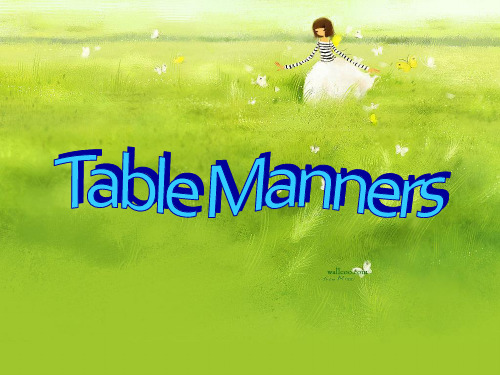
Manners in China
1)Spitting Out the Bones In China it is common practice to spit things out on the table or the floor. Often food has small pieces of bone or other inedible parts that need to be removed from the mouth. Using chopsticks, a hand or a tissue is a polite way around the problem.
The order of dishes in China
The meal usually begins with a set of at least four cold dishes, to be followed by the main courses of hot meat and vegetable dishes. Soup then will be served to be followed by staple food ranging from rice, noodles to dumplings. If you wish to have your rice to go with other dishes, you should say so in good time, for most of the Chinese choose to have the staple food at last or have none of them at all.
For the main or meat curse, the English keep the fork in the left hand, point curved downward, and bring the food to the mouth either by sticking the points onto it or in the case of soft vegetables, by placing it firmly on the fork in this position with the knife.
中西方餐桌礼仪差异 九年级英语作文

中西方餐桌礼仪差异九年级英语作文全文共6篇示例,供读者参考篇1Differences in Table Manners Between East and WestHello everyone! Today, I want to talk about something interesting—differences in table manners between East and West. Table manners are the way we behave while eating, and they can vary a lot from one culture to another. Let's explore some of these differences!In Western countries, it is common to eat with a knife, fork, and spoon. Each person has their own set of utensils, and they use them to eat their food. It's important to hold the knife in the right hand and the fork in the left hand. When eating, they cut their food into small pieces and then eat it with the fork. Also, it is polite to keep your elbows off the table while eating.In China and many other East Asian countries, we use chopsticks to eat. Chopsticks are thin, long sticks that are usually made of wood or bamboo. We hold one chopstick in each hand and use them to pick up food. It takes some practice to use them properly, but once you get the hang of it, it's really fun! InChinese culture, it is considered impolite to stab food with chopsticks or point them at others while eating.Another difference is the way we drink during meals. In the West, it is common to drink from a glass or cup, and it's okay to take small sips while eating. However, in China, we usually drink from small bowls or cups and we take big gulps of soup or tea. It is also polite to refill other people's cups when they are empty as a sign of respect and generosity.One more interesting difference is the way we express our appreciation for the food. In Western culture, it is polite to say "please" and "thank you" to the host or the person who prepared the meal. You can say things like "Please pass the salt" or "Thank you for the delicious meal." In Chinese culture, we often say "吃饭了" (chī fàn le), which mea ns "Let's eat" before we start our meal. We also use phrases like "好吃" (hǎo chī), which means "delicious," to show our appreciation.Remember, it's important to respect and understand different cultures, including their table manners. When we visit someone from a different culture or have guests from another country, it's a good idea to learn a little about their customs and try to follow them. By doing this, we can show that we are respectful and open-minded individuals.In conclusion, table manners can vary greatly between East and West. Whether it's the utensils we use, the way we drink, or how we express appreciation, these differences reflect the unique traditions and customs of each culture. So let's embrace diversity and enjoy the delicious food from all around the world!I hope you enjoyed learning about the differences in table manners between East and West. Have a great day, everyone!篇2Differences in Table Manners Between China and the WestHello everyone! Today, I want to tell you about the differences in table manners between China and the West. Table manners are important because they show respect to others and make dining a pleasant experience for everyone. Let's explore some interesting differences!In China, it is polite to slurp your noodles while eating. It may seem strange to some people, but it's a way of showing that you are enjoying the meal. In the West, however, it is considered impolite to make noise while eating. So, if you are visiting a Western country, remember to eat quietly.Another difference is the use of chopsticks and forks. In China, we use chopsticks to eat most of our meals. Chopsticks are held in one hand and used to pick up food. However, in the West, people usually use forks and knives. They hold the fork in their left hand and the knife in their right hand to cut the food. Then, they switch the fork to their right hand to eat. It's interesting how different tools can be used for the same purpose!When it comes to seating arrangements, there's a difference too. In China, the host usually sits facing the door as a sign of respect to the guests. The most honored guest is seated on the host's right side. In the West, there are no strict rules about seating arrangements. People usually choose their seats freely, and the host can sit anywhere. It's nice to know these differences so we can be respectful when we have guests from different cultures.One more difference is the way we offer and receive food. In China, it is polite to offer food to others before serving yourself. We often say "请吃" (qǐng chī), which means "please eat," as a way of showing politeness. On the other hand, in the West, it is common for people to serve themselves first and then offer foodto others. It's important to be aware of these customs to avoid any misunderstandings.Lastly, let's talk about the use of utensils during the meal. In China, it is common to use chopsticks for everything, including picking up rice. It may take some practice to master the art of using chopsticks, but it's a fun skill to learn. In the West, forks and knives are used for cutting and eating food. They also use spoons for soup or desserts. It's interesting how different cultures have their own unique ways of enjoying a meal!In conclusion, there are many differences in table manners between China and the West. From how we eat noodles to the use of utensils and seating arrangements, each culture has its own customs and traditions. By being aware of these differences, we can show respect and have a better understanding of each other's cultures. So, let's embrace diversity and enjoy our meals together, no matter where we are from!I hope you enjoyed learning about the differences in table manners between China and the West. Remember, it's always good to be respectful and open-minded when it comes to different customs. Happy dining!篇3中西方餐桌礼仪差异大家好!我是小明,今天我想和大家分享一下中西方餐桌礼仪的差异。
中西方餐桌礼仪英语作文
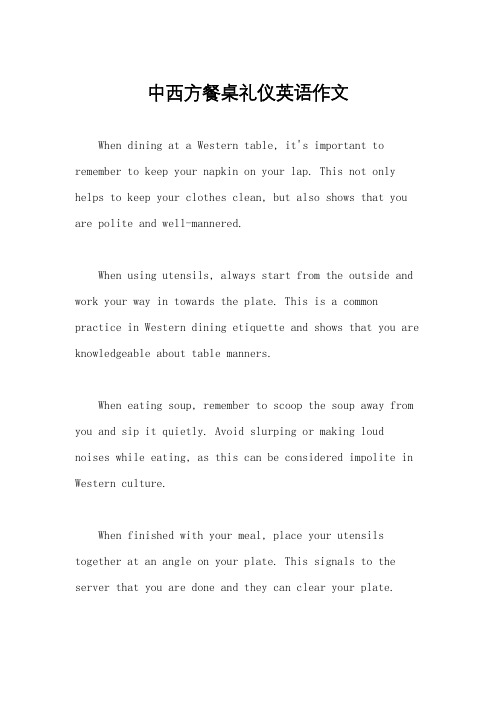
中西方餐桌礼仪英语作文When dining at a Western table, it's important to remember to keep your napkin on your lap. This not only helps to keep your clothes clean, but also shows that you are polite and well-mannered.When using utensils, always start from the outside and work your way in towards the plate. This is a common practice in Western dining etiquette and shows that you are knowledgeable about table manners.When eating soup, remember to scoop the soup away from you and sip it quietly. Avoid slurping or making loud noises while eating, as this can be considered impolite in Western culture.When finished with your meal, place your utensils together at an angle on your plate. This signals to the server that you are done and they can clear your plate.If you need to leave the table during the meal, remember to excuse yourself and place your napkin on your chair. This signals to others that you will be returning and helps to maintain a sense of politeness at the table.Overall, following these simple table manners can help you navigate a Western dining experience with ease and confidence. Remember to be polite, respectful, and mindful of those around you as you enjoy your meal.。
西方和中国的餐桌礼仪差异英语作文
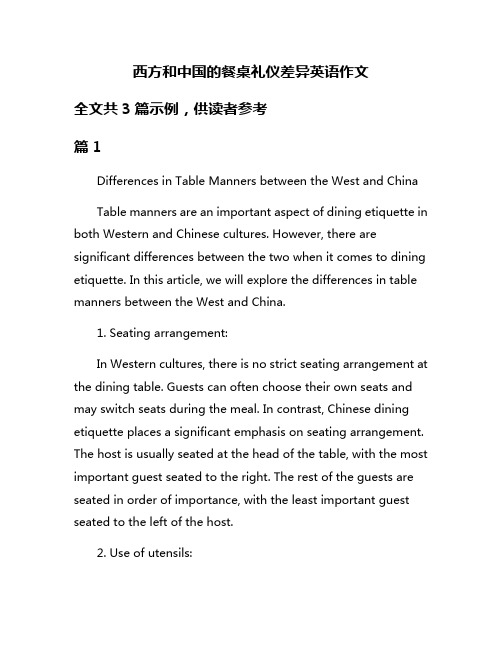
西方和中国的餐桌礼仪差异英语作文全文共3篇示例,供读者参考篇1Differences in Table Manners between the West and ChinaTable manners are an important aspect of dining etiquette in both Western and Chinese cultures. However, there are significant differences between the two when it comes to dining etiquette. In this article, we will explore the differences in table manners between the West and China.1. Seating arrangement:In Western cultures, there is no strict seating arrangement at the dining table. Guests can often choose their own seats and may switch seats during the meal. In contrast, Chinese dining etiquette places a significant emphasis on seating arrangement. The host is usually seated at the head of the table, with the most important guest seated to the right. The rest of the guests are seated in order of importance, with the least important guest seated to the left of the host.2. Use of utensils:In Western cultures, diners typically use a knife and fork to eat their meals. The fork is held in the left hand, while the knife is held in the right hand. In Chinese dining etiquette, chopsticks are the primary utensil used for eating. Diners are expected to use chopsticks to pick up food from communal dishes and their own bowls. It is considered rude to use chopsticks to point at people or to spear food with chopsticks.3. Noise level:In Western cultures, it is generally acceptable to engage in lively conversation and laughter during a meal. However, in Chinese dining etiquette, it is considered impolite to make loud noises while eating. Diners are expected to eat quietly and to avoid talking with their mouths full. It is also considered rude to slurp noodles or soup.4. Serving and accepting food:In Western cultures, it is common for diners to serve themselves from communal dishes or to have food passed around the table. In Chinese dining etiquette, the host is responsible for serving food to the guests. Diners should wait for the host to offer them food before taking any themselves. It is also considered polite to accept food with both hands as a sign of respect.5. Drinking etiquette:In Western cultures, it is common for diners to toast each other with alcoholic beverages during a meal. In Chinese dining etiquette, toasting is also common, but it is important to pay attention to the order in which toasts are made. The oldest or most senior person at the table should make the first toast, and others should follow suit, starting with the most important guest and then moving down in order of importance.In conclusion, there are significant differences in table manners between the West and China. Understanding these differences can help to avoid misunderstandings and ensure a pleasant dining experience in both cultures. By following the appropriate etiquette, diners can show respect for their hosts and fellow guests while enjoying a delicious meal together.篇2Differences in Table Manners Between Western and Chinese CulturesTable manners are an essential part of dining etiquette in both Western and Chinese cultures. However, there are significant differences in how each culture approaches and adheres to these customs. Understanding and respecting thesedifferences is crucial when dining with people from different cultural backgrounds. In this essay, we will explore and compare the table manners of Western and Chinese cultures.In Western cultures, particularly in Europe and North America, table manners are generally more formal compared to Chinese culture. This formality is evident in various aspects of dining etiquette, such as how one holds their utensils, the order in which dishes are served, and the use of napkins. For example, in Western cultures, it is common to hold a fork in the left hand and a knife in the right hand while cutting and eating food. In contrast, in Chinese culture, chopsticks are held in the right hand and used to pick up food from shared dishes.Another key difference in table manners between Western and Chinese cultures is the seating arrangement. In Western cultures, there is often a designated seating plan, with guests assigned to specific seats at the dining table. The host typically sits at the head of the table, and guests are seated based on their relationship to the host. In Chinese culture, seating arrangements are less formal, and guests may choose their seats based on their preferences or social status.Furthermore, in Western cultures, it is customary to wait for everyone to be served before starting to eat. It is also consideredpolite to wait for the host to begin eating before taking the first bite. In Chinese culture, it is common for diners to start eating as soon as the first dish is served, and there is less emphasis on waiting for others to start eating.The way dishes are served and shared also differs between Western and Chinese cultures. In Western cultures, individual plates or portions are served to each diner, and it is uncommon to share dishes during a meal. In Chinese culture, meals are typically served family-style, with multiple dishes placed on the table for everyone to share. This communal style of dining promotes a sense of togetherness and sharing among diners.Another important aspect of table manners is the use of utensils and tableware. In Western cultures, knives, forks, and spoons are the primary utensils used for eating. Napkins are placed on laps and used to wipe hands or mouths during the meal. In Chinese culture, chopsticks are the primary utensils, and diners use small bowls for rice and soup. It is also common for diners to use a small plate or bowl to discard food scraps while eating.In conclusion, while table manners may vary between Western and Chinese cultures, the underlying principles of respect, courtesy, and consideration for others remain constant.By understanding and respecting the differences in table manners between cultures, we can bridge cultural divides and create more meaningful and inclusive dining experiences. It is essential to approach cultural differences with an open mind and a willingness to learn from others.篇3Differences in Table Manners between the West and ChinaTable manners vary greatly across different cultures and countries, reflecting the unique customs and traditions of each society. In this essay, we will explore the differences in table manners between the West and China.In the West, dining etiquette is often formal and structured. For example, in Western countries, it is customary to place the napkin on one’s lap as soon as one sits down at the table. This signals to the host or hostess that you are ready to eat. In China, however, people often place the napkin on the table next to their plates, as it is believed to be more polite.One of the most noticeable differences between Western and Chinese table manners is the use of chopsticks. In China, chopsticks are a staple utensil used to pick up food, while in the West, forks, knives, and spoons are the primary utensils.Westerners may find using chopsticks difficult at first, but it is a skill that can be mastered with practice.In the West, it is considered polite to wait for everyone at the table to be served before beginning to eat. This demonstrates respect for others and ensures that everyone can enjoy the meal together. In China, however, it is common for people to start eating as soon as their food is served. This difference in etiquette can sometimes lead to misunderstandings or confusion between Westerners and Chinese diners.Another key difference in table manners between the West and China is the way food is shared. In Chinese culture, it is customary to order several dishes and share them family-style. This encourages interaction and bonding among diners. In the West, individual portions are served, and it is considered impolite to reach across the table to take food from someone else's plate.In the West, it is also common to leave a small amount of food on one’s plate as a sign that the meal was satisfying and the portion size was adequate. In China, however, it is generally expected that one will finish all the food on their plate as a sign of appreciation for the meal and the chef's efforts.Ultimately, while there are clear differences in table manners between the West and China, the important thing to remember is to be respectful and open-minded when dining with people from different cultures. By understanding and respecting each other’s customs and traditions, we can create a more inclusive and welcoming dining experience for everyone.。
中西餐礼仪(英文版)

勺子
它的主要作用是舀取菜肴、 食物。有时,用筷子取食时,也 可以用勺子来辅助。尽量不要单 用勺子去取菜。用勺子取食物时, 不要过满,免得溢出来弄脏餐桌 或自己的衣服。在舀取食物后, 可以在原处“暂停”片刻,汤汁 不会再往下流时,再移回来享用。
暂时不用勺子时,应放在自己 的碟子上,不要把它直接放在餐桌 上,或是让它在食物中“立正”。 用勺子取食物后,要立即食用或放 在自己碟子里,不要再把它倒回原 处。而如果取用的食物太烫,不可 用勺子舀来舀去,也不要用嘴对着 吹,可以先放到自己的碗里等凉了 再吃。不要把勺子塞到嘴里,或者 反复吮吸、舔食。
西餐礼仪
进食西餐,有许多的礼仪 让我们无所适从,时而担 心各个动作是否形象到了 自己的美好形象,入座、 餐具的摆设、刀叉的使用 方法,正确的食肉方式等 等都能表现我们的修养和 气质。
入座篇
西餐的位置排列与中餐有相 当大的区别,中餐多使用圆桌 ,而西餐一般都使用长桌。 进 入西餐厅后,由服务生带领入 坐,不可冒然入位。男士或服 务生可帮女士拉开椅子协助入 座,一般由椅子左侧入座。座 位的安排于离出口最远的位置 为上位。
宴会用餐礼仪
• 如果你参加正式宴请的话,女主人把餐巾铺在腿上是宴会开始的标志 。餐巾暗示着宴会的开始和结束,西方有讲女士优先的原则,西餐宴 会上女主人是第一顺序,女主人不坐,别人是不能坐的,女主人把餐 巾铺在腿上就说明大家可以开动。反之,女主人要把餐巾放在桌子上 了,是宴会结束的标志。 开始进餐时,取菜时不要盛得过多,盘中食物吃完后如果不够,可以 再取,用餐前应先将餐巾打开铺在膝上,餐后叠好放在盘子右边,不 可放在椅子上,亦不可叠得方方正正而被误认为未用过。餐巾可擦嘴 不可擦汗。
中西方餐桌礼仪英文

3)Noise and Smoking Eating noisily is allowed in China.Slurping, smacking the lips and leaving the mouth open when eating can be viewed as demonstrating enjoyment of the food and a friendly atmosphere in China. Smoking is also permitted in most Chinese restaurants. A way round this, in larger restaurants, is to request a side room for your meal, which will have its own door to insulate you from the noise and smoke.
Manners in the West
1) As soon as the hostess picks up her napkin, pick yours up and lay it on your lap. Sometimes a roll of bread is wrapped in it; if so, toke it our and put it on your side plate. 2) The Soup Course Dinner usually begins with soup. The largest spoon at your place is the soup spoon. It will be beside your plate at the right-hand side.
东西方餐桌礼仪英文版
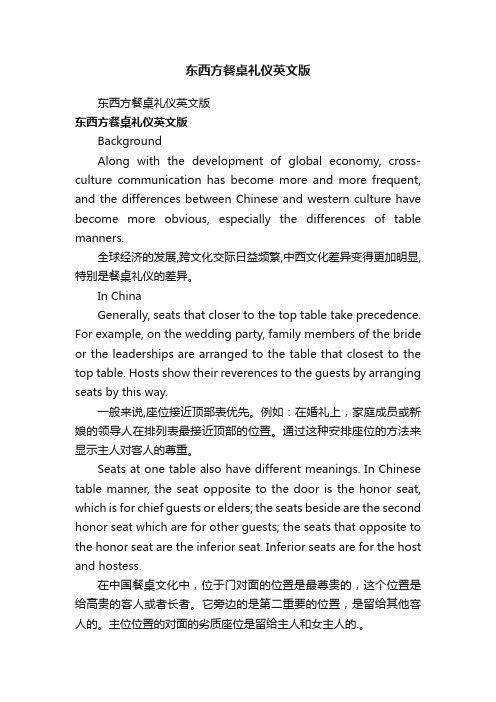
东西方餐桌礼仪英文版东西方餐桌礼仪英文版东西方餐桌礼仪英文版BackgroundAlong with the development of global economy, cross-culture communication has become more and more frequent, and the differences between Chinese and western culture have become more obvious, especially the differences of table manners.全球经济的发展,跨文化交际日益频繁,中西文化差异变得更加明显,特别是餐桌礼仪的差异。
In ChinaGenerally, seats that closer to the top table take precedence. For example, on the wedding party, family members of the bride or the leaderships are arranged to the table that closest to the top table. Hosts show their reverences to the guests by arranging seats by this way.一般来说,座位接近顶部表优先。
例如:在婚礼上,家庭成员或新娘的领导人在排列表最接近顶部的位置。
通过这种安排座位的方法来显示主人对客人的尊重。
Seats at one table also have different meanings. In Chinese table manner, the seat opposite to the door is the honor seat, which is for chief guests or elders; the seats beside are the second honor seat which are for other guests; the seats that opposite to the honor seat are the inferior seat. Inferior seats are for the host and hostess.在中国餐桌文化中,位于门对面的位置是最尊贵的,这个位置是给高贵的客人或者长者。
中西方餐桌礼仪英文介绍
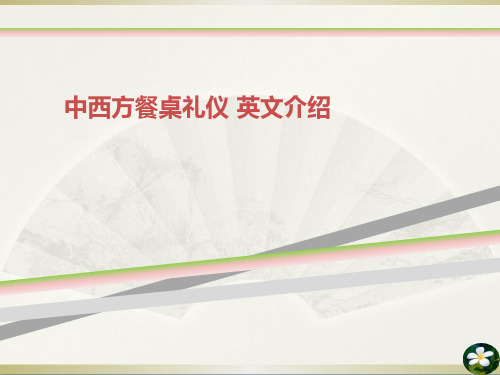
2.清朝黄遵宪曾作诗曰:“钟声一及时,顷刻不少留。虽
有万钧柁,动如绕指柔。”这是在描写
()
A.电话
B.汽车
C.电报
D.火车
解析:从“万钧柁”“动如绕指柔”可推断为火车。
答案:D
[典题例析]
[例1] 上海世博会曾吸引了大批海内外人士利用各种
交通工具前往参观。然而在19世纪七十年代,江苏沿江
居民到上海,最有可能乘坐的交通工具是
• YOU should have a good posture.
•入座后姿式端正,脚踏在本人座位下,不可任意伸 直,手肘不得靠桌缘, 或将手放在邻座椅背上。
入座位置
In CHINA
客齐后导客入席,以左为上,视为 首席,相对首座为二座,首座之下 为三座,二座之下为四座。
IN WEST
一般说来,面对门的离门最远的那个座位是女主人的,与 之相对的是男主人的座位。女主人右手边的座位是第一主宾 席,一般是位先生;男主人右边的座位是第二主宾席、一般 是主宾的夫人。女主人左边的座位是第三主宾席,男主人的 左边的座位是第四主宾席。
如果要给客人或长辈布 菜.最好用公筷.也可以把离 客人或长辈远的菜肴送到 他们跟前,按我们中华民族 的习惯.菜是一个一个往上 端的.如果同桌有领导,老人, 客人的话.每当上来一个新 菜时就请他们先动筷子.或 着轮流请他们先动筷子.以 表示对他们的重视.
吃到鱼头,鱼刺,骨头等 物时,不要往外面吐,也不 要往地上仍.要慢慢用手 拿到自己的碟子里,或放 在紧靠自己餐桌边或放 在事先准备好的纸上
D.航空运输
解析:根据所学1872年李鸿章创办轮船招商局,这是洋务
运动中由军工企业转向兼办民用企业、由官办转向官督商
办的第一个企业。具有打破外轮垄断中国航运业的积极意
中西方餐桌礼仪英文

Tableware 餐具
Chopsticks are used to eat most kinds of Chinese foods.Hold your chopsticks towards their end, not in the middle or the front third when dining with them. When you are not using your chopsticks, or have finished eating, lay them down in front of you with the tips to left.
Manners in China 中方礼仪
1)Spitting Out the Bones In China it is common practice to spit things out on the table or the floor. Often food has small pieces of bone or other inedible parts that need to be removed from the mouth. Using chopsticks, a hand or a tissue is a polite way around the problem.
SITTING 入席
In China, any banquet, only will have one form, will be everybody sits in a circle all round. The banquet must use the round table, this formally has created one kind of unity, politeness, altogether the interest atmosphere. The delicacy delicacies place a table of person's center, it is not only the object which table of people appreciate, taste, is also a table of person sentiment exchange intermedium. Westerners treat with a long table, men and women sit in the owner at both ends, and then the guest of honor men and women in the press and the general order of the guests seating arrangements.
中西餐礼仪英文版
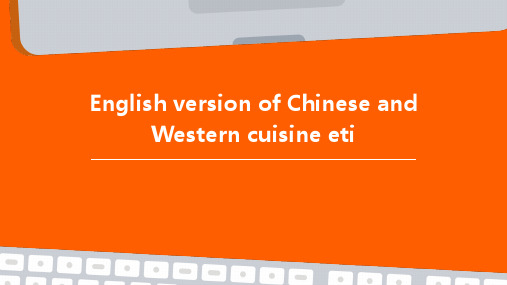
Placement and use of tableware
Glass
The glass is placed on the right side of the plate, and it is used to drink water or other drinks
Napkin
The napkin is placed on the left side of the plate, and it is used to wide hands or south
Comparison of tableware usage
Chopsticks vs. Knives and Forks
In Chinese cuisine, chokes are the primary utensils used, while in Western cuisine, knots and forks are standard Chopsticks are used for grazing and cutting food, while knots and forks are used for speaking and cutting food
Plate
The plate is placed in front of the diner, and the food is placed on the plate The plate is moved to the left when taking food, and the knife is placed on the right side of the plate
If someone orders a dish that they do not want to share, they should be respected
英语课件中西方餐桌礼仪_演示文稿

中西方餐桌礼仪
1
Table manners 1 入座的礼仪 2 Dining etiquette 2 进餐时的礼仪
3
The absence of etiquette
3 离席时的礼仪
入座的礼仪 Table manners
• To please the guests seated on the seats, then please elderly 先请客人入座上席,再请长者入座客人旁依次入座; • 入座时要从椅子左边进入,入座后不要动筷子,更不要弄 guests are seated beside the table; When seated to the left to enter from the chair at the table, do 出什么响声来,也不要起身走动;如果有什么事要向主人打 not 。 招呼 move chopsticks, not to get what the noise, also don't get
Dining etiquette进餐的礼仪
了。
Please请客人、长者动筷子。夹菜时每次少一些,离自己远的菜就少吃 • the guests, elders move chopsticks. Food every time less, far from the food on their own to eat less. Do not eat out sound; when soup is not sound, using 一些。吃饭时不要出声音;喝汤时不要出声响,用汤匙一小口一小 a spoon SIP one drink, should not take the bowl to the mouth to drink, soup is not 口地喝,不宜把碗端到嘴边喝,汤太热时不要一边吹一边喝,等凉 blowing while drinking, such as the cold after the drink. Some people like to eat 了以后再喝。有的人吃饭喜欢用咀嚼食物.特别是使劲咀嚼脆食物, with chewing food. Especially hard crisp chewing food, a very clear voice. This is 发出很清晰的声音来.这种做法是不合礼仪要求的,特别是和众人一 not etiquette demands, special and everyone is eating together, as far as possible 起进餐时,就要尽量防止出现这种现象。 to prevent the occurrence of this phenomenon. Don't burp when eating, do not appear in other voices. If sneezing, bowel, can't • 进餐时不要打嗝,也不要出现其他声音。如果出现打喷嚏、肠鸣 help sound, it is necessary to say "I feel shy"," sorry"," please forgive" and the like, 等不由自主的声响时,就要说一声“真不好意思”、“对不起”、 to apologize.
中国餐桌礼仪英语作文
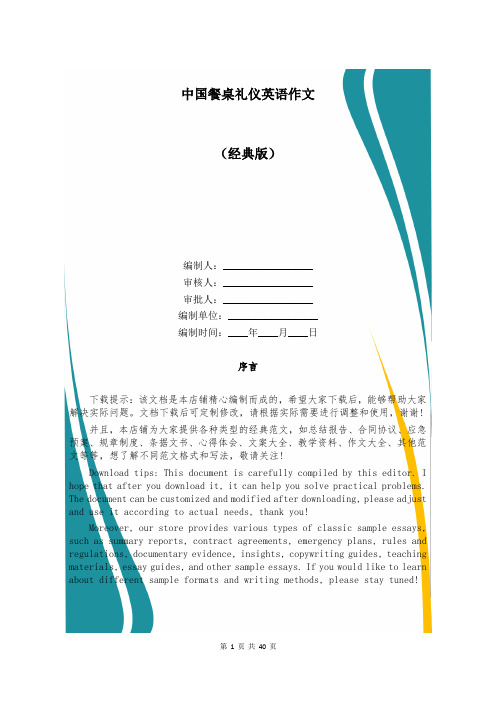
中国餐桌礼仪英语作文(经典版)编制人:__________________审核人:__________________审批人:__________________编制单位:__________________编制时间:____年____月____日序言下载提示:该文档是本店铺精心编制而成的,希望大家下载后,能够帮助大家解决实际问题。
文档下载后可定制修改,请根据实际需要进行调整和使用,谢谢!并且,本店铺为大家提供各种类型的经典范文,如总结报告、合同协议、应急预案、规章制度、条据文书、心得体会、文案大全、教学资料、作文大全、其他范文等等,想了解不同范文格式和写法,敬请关注!Download tips: This document is carefully compiled by this editor. I hope that after you download it, it can help you solve practical problems. The document can be customized and modified after downloading, please adjust and use it according to actual needs, thank you!Moreover, our store provides various types of classic sample essays, such as summary reports, contract agreements, emergency plans, rules and regulations, documentary evidence, insights, copywriting guides, teaching materials, essay guides, and other sample essays. If you would like to learn about different sample formats and writing methods, please stay tuned!中国餐桌礼仪英语作文中国餐桌礼仪英语作文(通用17篇)在平平淡淡的日常中,大家总少不了接触作文吧,作文根据写作时限的不同可以分为限时作文和非限时作文。
各国的餐桌礼仪英文版
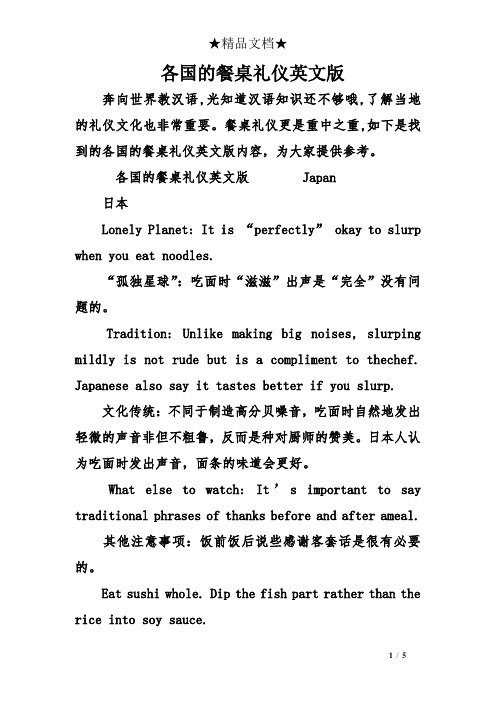
各国的餐桌礼仪英文版奔向世界教汉语,光知道汉语知识还不够哦,了解当地的礼仪文化也非常重要。
餐桌礼仪更是重中之重,如下是找到的各国的餐桌礼仪英文版内容,为大家提供参考。
各国的餐桌礼仪英文版Japan日本Lonely Planet: It is “perfectly” okay to slurp when you eat noodles.“孤独星球”:吃面时“滋滋”出声是“完全”没有问题的。
Tradition: Unlike making big noises, slurping mildly is not rude but is a compliment to thechef. Japanese also say it tastes better if you slurp.文化传统:不同于制造高分贝噪音,吃面时自然地发出轻微的声音非但不粗鲁,反而是种对厨师的赞美。
日本人认为吃面时发出声音,面条的味道会更好。
What else to watch: It’s important to say traditional phrases of thanks before and after ameal.其他注意事项:饭前饭后说些感谢客套话是很有必要的。
Eat sushi whole. Dip the fish part rather than the rice into soy sauce.寿司要一口吃掉。
应该用鱼生的部分来蘸取酱油,而不是米饭的部分。
Russia俄罗斯Lonely Planet: Your wrists should be placed on the edge of the table while eating, fork in lefthand, knife in the right.“孤独星球”:用餐时手腕要放在桌子边缘,左手拿叉,右手拿刀。
Tradition: Keep your hands in sight. It is not good manners to rest them on your lap. Keepyour elbows off the table.文化传统:双手要保持在别人的视线内。
中西方餐桌礼仪英语作文80词

中西方餐桌礼仪英语作文80词篇1In the vast expanse of global culture, the differences in table manners between China and the West are truly remarkable! Let's explore these contrasts and embrace the beauty of each culture's unique approach.In China, it is a profound tradition for the elders to start eating first, showing respect for their seniority. When toasting, one must hold the glass lower than that of the elder or respected person. Such acts reflect the importance of hierarchy and respect in Chinese culture.On the contrary, in the West, the use of tableware is highly emphasized. Knives and forks are used precisely and elegantly. During meals, maintaining appropriate conversation is crucial. But loud and boisterous exchanges are often avoided.The contrast in table manners between China and the West not only showcases the diversity of cultures but also reminds us of the significance of understanding and respecting these differences. Isn't it amazing how different cultures shape our dining experiences?篇2In the vast realm of cultural diversity, the contrast between Chinese and Western table manners is truly remarkable! Chinese table etiquette often reflects the deep-rooted concepts of family and the orderly hierarchyof elders and juniors. For instance, during a family feast, the elders are seated first, and the youngest ones show respect by waiting to be served. This tradition emphasizes the importance of family unity and hierarchy.On the contrary, Western table manners showcase individualism and equality. Everyone has the right to express their opinions freely and make choices independently. Isn't it fascinating how in the West, the focus is more on personal preferences and equality among diners?The differences in these table manners aren't just about behavior; they delve deep into the core of cultural values. They reveal how different societies prioritize and perceive various aspects of life. How astonishing and thought-provoking these contrasts are!篇3When it comes to table manners, both in the East and the West, there are significant differences that reflect the unique cultures. In a Chinese family gathering, it is common to wait for the elders to start eating first. People often use chopsticks skillfully and share dishes. It's polite to show respect by not making too much noise while eating. But in a Western business banquet, a different scene unfolds. Formal cutlery like knives and forks are used. Before starting, it's important to wait for the host to indicate. One should eat quietly and avoid talking with a mouthful of food. Oh, how fascinating these differences are! Don't you think it's essential to understand them to show respect and build good relationships?Understanding different table manners can truly deepen our comprehension of various cultures. Isn't it wonderful to explore these cultural diversities?篇4In today's globalized world, the integration and development of Chinese and Western table manners have become an intriguing topic. How do we strike a balance and create harmony when it comes to dining etiquette? Take international conferences for instance. At such events, planners have to consider a multitude of factors. They need to accommodate the preferences of both Chinese and Western guests. For the seating arrangement, it's not just about putting people randomly. There are cultural nuances to be aware of! The choice of utensils also poses a challenge. Do we use chopsticks or knives and forks? And what about the sequence of courses? In China, it might follow a certain traditional order, while in the West, it could be different. Oh, the complexity of it all! But isn't it wonderful to see how these diverse cultures come together and find common ground in the realm of table manners? This process of integration is not only about food and etiquette, but also about mutual respect and understanding. Isn't that what makes our world more colorful and connected?篇5Oh my goodness! Let me tell you about my fascinating experiences with table manners in China and the West. Once, when I dined in a Western restaurant, I was amazed by the elaborate cutlery and the strict rules of placing them. I had to be so careful not to make a mistake! And when my foreign friends came to have a meal in China, they were quite surprised by the sharing of dishes and the热闹atmosphere. We had so much fun explaining and learning from each other. For instance, in the West, it's considered impolite to talk with your mouth full, but in China, lively conversations during meals are common and add to the joy. Isn't it interesting how different cultures have such diverse ways of enjoying food?I truly believe that understanding these differences not only enriches our knowledge but also helps us build better connections with people from all over the world. How wonderful it is to explore these cultural treasures through our dining experiences!。
全面介绍西餐礼仪英文版(中英对照)
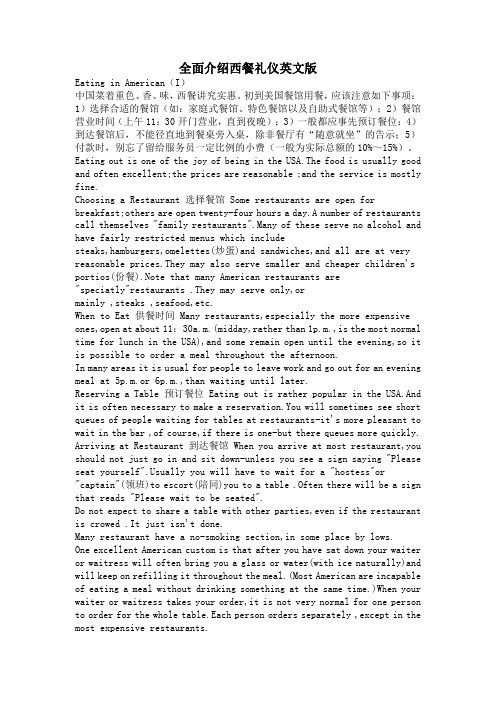
全面介绍西餐礼仪英文版Eating in American(I)中国菜着重色、香、味,西餐讲究实惠。
初到美国餐馆用餐,应该注意如下事项:1)选择合适的餐馆(如:家庭式餐馆、特色餐馆以及自助式餐馆等);2)餐馆营业时间(上午11:30开门营业,直到夜晚);3)一般都应事先预订餐位:4)到达餐馆后,不能径直地到餐桌旁入桌,除非餐厅有“随意就坐”的告示;5)付款时,别忘了留给服务员一定比例的小费(一般为实际总额的10%~15%)。
Eating out is one of the joy of being in the USA.The food is usually good and often excellent;the prices are reasonable ;and the service is mostly fine.Choosing a Restaurant 选择餐馆 Some restaurants are open for breakfast;others are open twenty-four hours a day.A number of restaurants call themselves "family restaurants".Many of these serve no alcohol and have fairly restricted menus which includesteaks,hamburgers,omelettes(炒蛋)and sandwiches,and all are at very reasonable prices.They may also serve smaller and cheaper children's portios(份餐).Note that many American restaurants are "speciatly"restaurants .They may serve only,ormainly ,steaks ,seafood,etc.When to Eat 供餐时间 Many restaurants,especially the more expensive ones,open at about 11:30a.m.(midday,rather than 1p.m.,is the most normal time for lunch in the USA),and some remain open until the evening,so it is possible to order a meal throughout the afternoon.In many areas it is usual for people to leave work and go out for an evening meal at 5p.m.or 6p.m.,than waiting until later.Reserving a Table 预订餐位 Eating out is rather popular in the USA.And it is often necessary to make a reservation.You will sometimes see short queues of people waiting for tables at restaurants-it's more pleasant to wait in the bar ,of course,if there is one-but there queues more quickly. Arriving at Restaurant 到达餐馆 When you arrive at most restaurant,you should not just go in and sit down-unless you see a sign saying "Please seat yourself".Usually you will have to wait for a "hostess"or "captain"(领班)to escort(陪同)you to a table .Often there will be a sign that reads "Please wait to be seated".Do not expect to share a table with other parties,even if the restaurant is crowed .It just isn't done.Many restaurant have a no-smoking section,in some place by lows.One excellent American custom is that after you have sat down your waiter or waitress will often bring you a glass or water(with ice naturally)and will keep on refilling it throughout the meal.(Most American are incapable of eating a meal without drinking something at the same time.)When your waiter or waitress takes your order,it is not very normal for one person to order for the whole table.Each person orders separately ,except in the most expensive restaurants.Summoning a waiter 召唤侍者 You may find your waiter unusually friendly.He may ask you how you are (You're supposed just to say "Fine"),inquire whether you have a good day and ,later on say that he hopes you will enjoy your meal.To summon a waiter in a American restaurant you may call "Bill",or "Mary",or "Claude",or whatever.Waiters and waitresses often actually introduce themselves when they first come to your table or wear name tags,you are permitted to use their first names.Paying the Bill 付款 The bill (often called the "check")comes usually with tax added but no service chare-though some restaurant do now add a service charge.The etiquette(规矩)books say that you should leave a ten per cent tip(小费)for lunch,fifteen per cent for dinner.The tip should be calculated on the basis of the total before the addition of tax. At many restaurant you can ask the waiter to bring the bill and than pay at a cash desk on the way out.Eating in American(II)美国人吃饭用刀叉,而且他们的用餐方式是很有讲究的。
有关中西方餐桌文化差异的英语作文
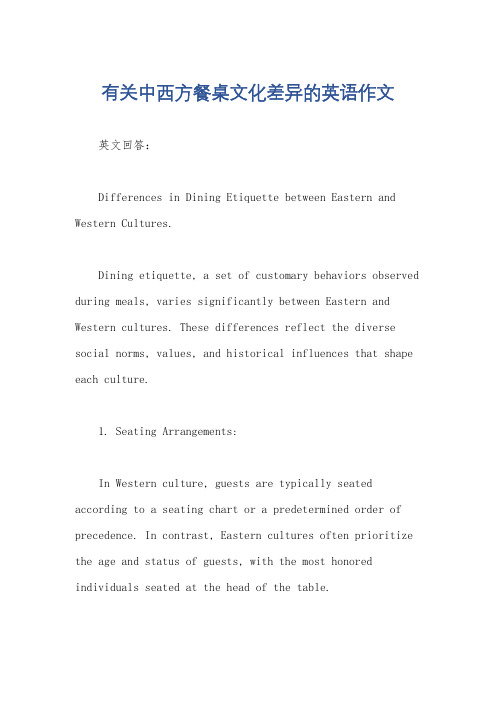
有关中西方餐桌文化差异的英语作文英文回答:Differences in Dining Etiquette between Eastern and Western Cultures.Dining etiquette, a set of customary behaviors observed during meals, varies significantly between Eastern and Western cultures. These differences reflect the diverse social norms, values, and historical influences that shape each culture.1. Seating Arrangements:In Western culture, guests are typically seated according to a seating chart or a predetermined order of precedence. In contrast, Eastern cultures often prioritize the age and status of guests, with the most honored individuals seated at the head of the table.2. Table Manners:Western etiquette dictates that utensils be held in a specific manner, with the fork in the left hand and the knife in the right. Food is cut into small pieces before being eaten. In Eastern cultures, chopsticks are the primary utensils, and food is typically shared from communal platters.3. Toasting:Toasting is a common practice in Western dining to honor guests or celebrate special occasions. In contrast, toasting is less prevalent in Eastern cultures, where it is often considered less respectful to raise one's glass in celebration while others are still eating.4. Meal Pacing:Western meals tend to be structured into courses, with each course served at a specific time. In Eastern cultures, meals are often more fluid, with dishes servedsimultaneously and guests encouraged to take their timewhile eating.5. Conversation:In Western settings, table conversation is typically more varied, covering a wide range of topics. In Eastern cultures, conversation is often more focused on the meal itself and the shared experience of dining together.6. Communal Dining:Communal dining is common in Eastern cultures, where shared meals symbolize unity and togetherness. In Western cultures, communal dining is less prevalent, except in specific social settings like potlucks or family gatherings.7. Dress Code:Western dining etiquette often includes a dress codethat varies depending on the occasion and setting. In Eastern cultures, dress code is typically more relaxed,with guests expected to dress comfortably and modestly.8. Dining Duration:Western meals tend to be shorter than Eastern meals, with guests typically spending less than an hour at the table. Eastern meals, on the other hand, can be more prolonged, lasting for several hours as guests socialize and enjoy the shared experience of dining.These are just a few of the many differences in dining etiquette between Eastern and Western cultures. Understanding these variations can help avoid misunderstandings and ensure a pleasant dining experience for all.中文回答:东西方餐桌文化差异。
各国餐桌礼仪详解 英文版
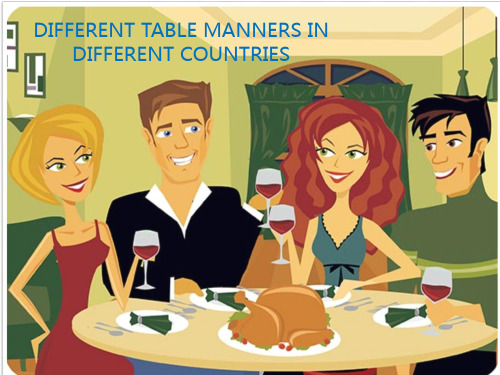
When you are eating in Britain...
The British generally pay a lot of attention to good table manners.
First, we should learn how to use a fork and knife.
A quick glance at the table setting
OK, here are some more tips to keep in mind
• if there is something to spit out his mouth, lips Didao should take a fork or your fingers out, and then moved to the edge of the plate. The whole process should not be cited as much as possible to pay attention to other people, after the meal can be naturally.
Put up the bowl Do not stick chopsticks vertically into your food, especially not into rice, as this will make Chinese think of funerals.
In China Don’t do these
How to eat desserts
To eat dessert, break the dessert with the spoon, one bite at a time. Push the food with the fork into the spoon. Eat from the spoon. (Fork in left hand; spoon in right.)
餐桌上的礼仪用英语介绍
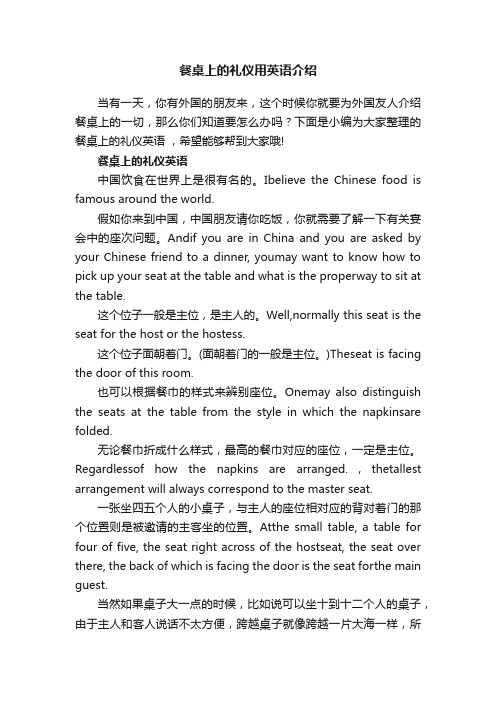
餐桌上的礼仪用英语介绍当有一天,你有外国的朋友来,这个时候你就要为外国友人介绍餐桌上的一切,那么你们知道要怎么办吗?下面是小编为大家整理的餐桌上的礼仪英语,希望能够帮到大家哦!餐桌上的礼仪英语中国饮食在世界上是很有名的。
Ibelieve the Chinese food is famous around the world.假如你来到中国,中国朋友请你吃饭,你就需要了解一下有关宴会中的座次问题。
Andif you are in China and you are asked by your Chinese friend to a dinner, youmay want to know how to pick up your seat at the table and what is the properway to sit at the table.这个位子一般是主位,是主人的。
Well,normally this seat is the seat for the host or the hostess.这个位子面朝着门。
(面朝着门的一般是主位。
)Theseat is facing the door of this room.也可以根据餐巾的样式来辨别座位。
Onemay also distinguish the seats at the table from the style in which the napkinsare folded.无论餐巾折成什么样式,最高的餐巾对应的座位,一定是主位。
Regardlessof how the napkins are arranged.,thetallest arrangement will always correspond to the master seat.一张坐四五个人的小桌子,与主人的座位相对应的背对着门的那个位置则是被邀请的主客坐的位置。
Atthe small table, a table for four of five, the seat right across of the hostseat, the seat over there, the back of which is facing the door is the seat forthe main guest.当然如果桌子大一点的时候,比如说可以坐十到十二个人的桌子,由于主人和客人说话不太方便,跨越桌子就像跨越一片大海一样,所以他们可以挨着坐,这种情况下是可以挨着坐的,这样坐主人和客人说话更方便一些。
西方和中国的餐桌礼仪差异英语作文
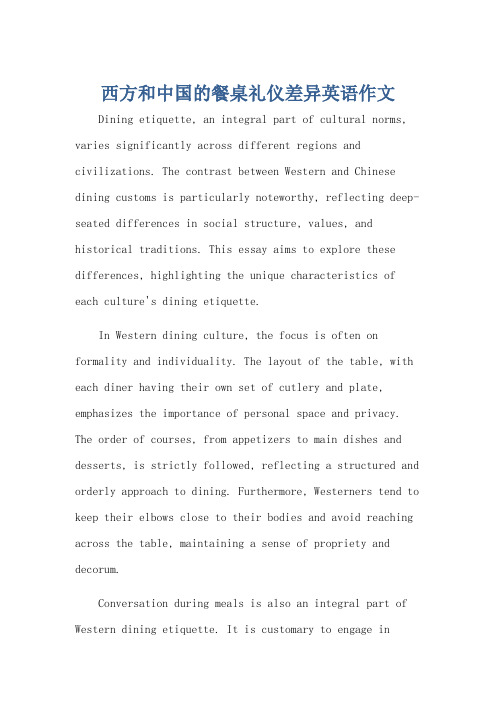
西方和中国的餐桌礼仪差异英语作文Dining etiquette, an integral part of cultural norms, varies significantly across different regions and civilizations. The contrast between Western and Chinese dining customs is particularly noteworthy, reflecting deep-seated differences in social structure, values, and historical traditions. This essay aims to explore these differences, highlighting the unique characteristics of each culture's dining etiquette.In Western dining culture, the focus is often on formality and individuality. The layout of the table, with each diner having their own set of cutlery and plate, emphasizes the importance of personal space and privacy. The order of courses, from appetizers to main dishes and desserts, is strictly followed, reflecting a structured and orderly approach to dining. Furthermore, Westerners tend to keep their elbows close to their bodies and avoid reaching across the table, maintaining a sense of propriety and decorum.Conversation during meals is also an integral part of Western dining etiquette. It is customary to engage inlight, polite chatter, often discussing topics unrelated to the food itself. This conversational aspect not only enhances the dining experience but also serves as a way to connect and bond with others.On the other hand, Chinese dining etiquette is marked by a strong emphasis on collectivism and harmony. The communal dining style, with dishes placed in the center of the table for everyone to share, fosters a sense of unity and community. Chopsticks, the traditional eating utensils, symbolize unity and harmony, as they are used by pairs. The host plays a pivotal role in Chinese dining, overseeing the flow of the meal and ensuring that everyone is well-fed and comfortable.Respect for elders and seniority is another crucial aspect of Chinese dining etiquette. It is customary for the eldest or most senior member of the group to take their seat first and for others to follow suit accordingly. Similarly, the host or the most senior diner ofteninitiates conversations, and others are expected to participate in a respectful and polite manner.Furthermore, silence during meals is not necessarily viewed as awkward or uncomfortable in Chinese culture. In fact, it can be interpreted as a sign of contentment and appreciation for the meal. However, this does not mean that conversation is discouraged; rather, it tends to be more subdued and focused on the meal itself or shared experiences.The differences in dining etiquette between the West and China reflect the unique values and traditions of each culture. Western dining culture emphasizes individuality, formality, and conversation, while Chinese dining etiquette focuses on collectivism, harmony, and respect. Understanding these differences can help us appreciate the rich diversity of cultural practices around the world and navigate cross-cultural dining experiences with greater ease and understanding.**中西餐桌礼仪差异**餐桌礼仪作为文化规范的重要组成部分,在不同地区和文明之间有着显著的差异。
论文-中西方餐桌礼仪对比(英文版)
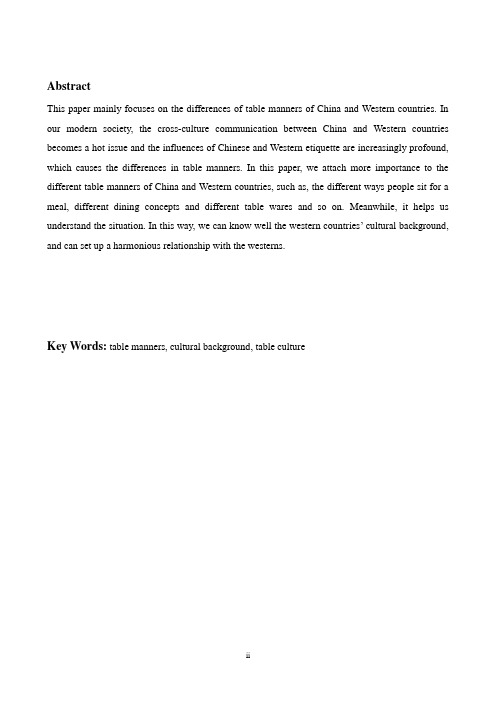
AbstractThis paper mainly focuses on the differences of table manners of China and Western countries. In our modern society, the cross-culture communication between China and Western countries becomes a hot issue and the influences of Chinese and Western etiquette are increasingly profound, which causes the differences in table manners. In this paper, we attach more importance to the different table manners of China and Western countries, such as, the different ways people sit for a meal, different dining concepts and different table wares and so on. Meanwhile, it helps us understand the situation. In this way, we can know well the western countries’ cultural background, and can set up a harmonious relationship with the westerns.Key Words: table manners, cultural background, table culture摘要本文主要讲中西方餐桌礼仪的不同点和相同点.在当今社会,随着中西方跨文化交流的平凡以及中西方礼仪的影响加深,导致双方餐桌礼仪方面的差异产生.本文着重于比较中西方在餐桌礼仪.例如,就餐是人们不同的入座方式,不同的饮食概念以及不同的餐具等等.此外还会指出不同国家中的一些用餐禁忌来帮助人们更好的理解餐桌礼仪。
- 1、下载文档前请自行甄别文档内容的完整性,平台不提供额外的编辑、内容补充、找答案等附加服务。
- 2、"仅部分预览"的文档,不可在线预览部分如存在完整性等问题,可反馈申请退款(可完整预览的文档不适用该条件!)。
- 3、如文档侵犯您的权益,请联系客服反馈,我们会尽快为您处理(人工客服工作时间:9:00-18:30)。
• YOU should have a good posture.
•入座后姿式端正,脚踏在本人座位下,不可任意伸 直,手肘不得靠桌缘, 或将手放在邻座椅背上。
入座位置
In CHINA
❖客齐后导客入席,以左为上,视为 首席,相对首座为二座,首座之下 为三座,二座之下为四座。
IN WEST
一般说来,面对门的离门最远的那个座位是女主人的,与 之相对的是男主人的座位。女主人右手边的座位是第一主宾 席,一般是位先生;男主人右边的座位是第二主宾席、一般 是主宾的夫人。女主人左边的座位是第三主宾席,男主人的 左边的座位是第四主宾席。
中西方餐桌礼仪
TABLE MANNERS
1 入座的礼仪 table etiquette
2 进餐时的礼仪 meal etiquette
3 离席时的礼仪 when asked the etiquette
table etiquette
•Make the elders have a sit first
先长者入座,客人依次入座; • 入座时要从椅子左边进入,入座后不要动筷子,更不要弄 出什么响声来,也不要起身走动;如果有什么事要向主人打 招呼 。
❖ 中方
①汤、菜 ②主食 ③餐酒 ④水果
上菜顺序
❖ 西方 ①菜 ②水果 ③餐酒 ④主食 ⑤甜点 、咖啡
meal etiquette
❖ 中方
❖ 筵席中暂时 停餐,可以 把筷子直搁 在碟子或者 调羹上。如 果将筷子横 搁在碟子上, 那是表示酒 醉饭饱不再 进膳了。
In China
Lay … on…
After completion, place the soiled napkin at the left of your place setting用餐完毕, 把用过的餐巾放 在摆设的左手边
西方进餐礼仪
——刀叉篇
•刀叉该如何拿?
•刀叉的使用,应该 右手持刀,左手持 叉,使用时叉齿朝 下,以拇指与中指 握住刀叉柄、食指 下压控制力道。
要适时地抽空和左右的人聊几句风 趣的话,以调和气氛.不要光着头吃饭,不 管别人,也不要狼吞虎咽地大吃一顿,更 不要贪杯.
最好不要在餐桌上剔牙.如果要剔牙 时,就要用餐巾或手挡住自己的嘴巴.
西方进餐礼仪
——餐巾篇
餐巾摊开应该放何处?
Unfold the napkin and fold it half before putting it on your lap
如果要给客人或长辈布 菜.最好用公筷.也可以把离 客人或长辈远的菜肴送到 他们跟前,按我们中华民族 的习惯.菜是一个一个往上 端的.如果同桌有领导,老人, 客人的话.每当上来一个新 菜时就请他们先动筷子.或 着轮流请他们先动筷子.以 表示对他们的重视.
吃到鱼头,鱼刺,骨头等 物时,不要往外面吐,也不 要往地上仍.要慢慢用手 拿到自己的碟子里,或放 在紧靠自己餐桌边或放 在事先准备好的纸上
将骨头吐到餐纸上,再将骨头 包覆在纸内,这样才不会带给主人 难堪。
西方进餐礼仪
——刀叉篇
•吃到中途离席,刀叉该如何放?
应该把刀叉朝八字型放置, 刀口朝内、叉齿朝下。
西方进餐礼仪
——刀叉篇
•吃完后,刀叉该如何放?
左:应放在四点钟位置。 右:应将刀叉重迭,这样方便服务生
收时,不至于因为刀叉碰撞而发 出声响,或是刀叉掉落的意外。
西方进餐礼仪
——面包篇
•位置:
通常主菜未上桌前,服务生会先提供餐包,放的位 置一定是在主菜左侧,所以餐具左侧的面包是属于你 的,不要拿错。吃面包时,直接在面包盘上剥开、涂 抹奶油,否则离开面包盘,面包屑容易掉得满桌都是,
不易收拾。
西方进餐礼仪
——面包篇
•涂抹法:
Break the bread with your fingers into small piece small enough for one bite, butter it
用手指把面包一小块的撕开 来, 涂黄油
Do not butter the entire piece of bread at one time
不要把整块面包涂 上黄油
西方进餐礼仪
——喝汤篇
擦鼻子
餐巾有分正反面,通常有 印该店LOGO的为正面, 要用反折的内侧来擦,擦 完盖在餐巾内侧不外露.
西方进餐礼仪
——餐巾篇 •暂时离。席餐巾放哪里?
Place the napkin on the chair if you need to be excused.
西方进餐礼仪
——餐巾篇 • 用餐完毕准备离席,餐巾应该放在哪里?
Put up the bowl Don't stick the chopsticks upright in the bowl.
DON’T
❖Slurp when drinking soup or eating noodles
喝汤和吃面条时发出声音
❖Keep the spoon inside the bowl or cup
西方进餐礼仪
——刀叉篇
•切法
使用刀子切食物,先将刀子轻轻推向前, 再用力拉回并向下切,这样就不会发出刺耳 声音了。
西方进餐礼仪
——刀叉篇
•叉法
西方进餐礼仪
------刀叉篇
• 主食该怎么切?
无论是香肠或排类,要切成 一口大小食用,由左至右切, 且要吃时再切。
• 吃到不好吃的东西或骨头, 该怎么办?
勺儿留在汤碗或茶杯里
❖Talk with your mouth full
满口食物时讲话
❖Chew with your mouth opened
咬食物时把嘴巴张开
•喝汤时,用汤匙一小口一小口地喝,不宜把碗端到嘴边喝, 汤太热时不要一边吹一边喝,等凉了以后再喝。有的人 吃饭喜欢用咀嚼食物.特别是使劲咀嚼脆食物,发出很清 晰的声音来.这种做法是不合礼仪要求的,特别是和众人 一起进餐时,就要尽量防止出现这种现象。
西方进餐礼仪
——餐巾篇
• 餐巾万一不小心滑下去怎么办?
西方进餐ห้องสมุดไป่ตู้仪
——餐巾篇
• 想擦嘴时该怎么办?
错误:用纸巾擦。 正确:Use the napkin to gently wipe your mouth. Don’t blow
your nose into your napkin 餐巾只用作轻擦嘴边。不可用来
